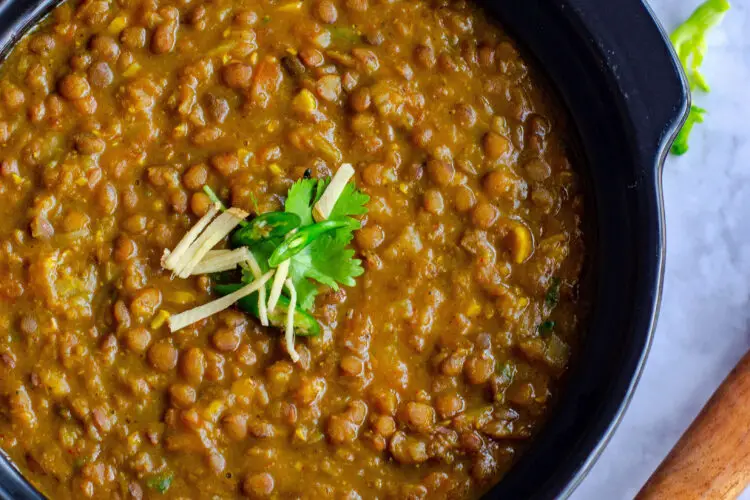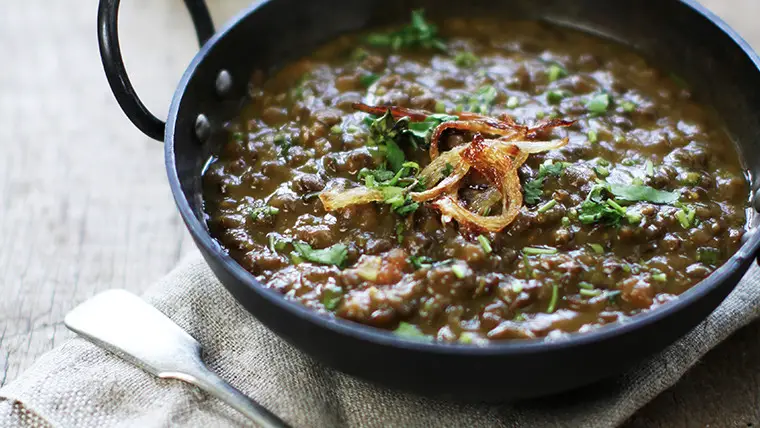Black Lentils (Kali Masoor ki Dal) cooked in the Instant Pot or stovetop. This simple and flavorful dal is vegan and gluten-free and pairs well with rice for a comforting meal.
Whole masoor dal is a lentil that is light brown in color on the outside, and orange in color on the inside (split masoor). Sabut masoor ki dal is usually made as a slightly thick curry. Some people also prefer to mash the dal to make its consistency thicker.
A popular dal in Punjabi households is made simple by adding the Tarka to the raw dal before cooking it all in a pressure cooker. You can of course boil/cook the dal first and then add the Tarka/vaghar on top.
Health benefits of black lentils
- Rich in fiber: Black lentils are an excellent source of dietary fiber. Fiber aids in digestion helps maintain bowel regularity, and promotes a feeling of fullness, which can aid in weight management.
- High in plant-based protein: Black lentils are a great source of plant-based protein, making them a valuable addition to vegetarian and vegan diets. Protein is essential for building and repairing tissues, supporting immune function, and maintaining healthy hair, skin, and nails.
- Nutrient-dense: Black lentils are packed with essential vitamins and minerals. They are a good source of iron, which is important for oxygen transport in the body and preventing iron-deficiency anemia. They also provide folate, magnesium, potassium, and zinc, which play vital roles in various bodily functions.
- Low in fat and cholesterol-free: Black lentils are naturally low in fat and do not contain cholesterol. They are heart-healthy food choices that can contribute to maintaining healthy blood cholesterol levels and reducing the risk of cardiovascular diseases.
- Blood sugar management: The high fiber content in black lentils helps regulate blood sugar levels by slowing down the absorption of glucose. This can be beneficial for individuals with diabetes or those at risk of developing the condition.
Ingredients for Black Lentils (Kali Masoor ki Dal)
- 200-gram black Lentils (Sabut/kali Masoor Dal/Indian Brown Lentils)
- 2 Onions ( Medium Size)
- 2 Tomatoes
- 1/2 Teaspoon Turmeric Powder
- 1 Teaspoon Cumin Seeds
- 1 pinch Asafoetida
- 1 Teaspoon Coriander Powder
- 1/2 Teaspoon Garam masala
- 1 Teaspoon Red Chilli Powder
- 1-Inch Ginger
- 4-5 Garlic Cloves
- 1–2 Green Chillies
- 1 Tablespoon Oil or Ghee
- salt as teste
- few Coriander Leaves
Instructions for Black Lentils (Kali Masoor ki Dal)
- Wash and rinse Whole or Kali Masoor Dal under cold running water until the water is clear.
- Heat a pressure cooker and add the cleaned entire masoor dal to it.
- Add salt, turmeric powder, and two to three glasses of water and Mix thoroughly.
- pressure cook for 10 to 12 minutes until the cooker makes three or four whistles.
- When there is no longer any steam, wait for the pressure cooker to cool before opening it. Dal needs to be tender but not mushy.
- On medium heat, heat a pan with some oil.
- Stir in the cumin seeds and watch them puff up. Add a pinch of asafoetida to the pan as well.
- Add two medium-sized sliced onions after that. For a few minutes, saute the onions.
- Add green chili, ginger, and garlic paste to the mixture.
- Cook the mixture till golden brown, which shows that the onions have been cooked thoroughly.
- To the mixture, add chopped or pureed tomatoes. Cook it in the pan until the tomatoes are soft and the gravy begins to take on a rich color.
- Now, add Garam masala, asafoetida, red chili powder, and coriander powder.
- There is no need to add salt or turmeric powder (haldi) because it has already added to the dal.
- Cook this gently until you notice the masala mixture beginning to release oil. By now, the tomatoes and onions ought to be tender.
- Mix in the cooked sabut masoor dal with this masala.
- For a few minutes, simmer the dal at a low to medium temperature.
- You can adjust the consistency of the dal by adding water as needed if it is too thick. Taste and add salt to taste as well.
- Add chopped coriander leaves or Kasuri methi as a garnish to Black Lentils (Kali Masoor ki Dal). Dal is prepared to go with a rice meal or some rotis.
Serving suggestions
Black Lentils (Kali Masoor ki Dal) go very well when served with Basmati rice or Jeera rice and rotis. Whole Masoor Dal is quite filling and comforting and many times is eaten in the main course without any other vegetable dish.
Tips for Black Lentils Recipe:
- Rinse the lentils thoroughly before cooking to remove any debris or impurities.
- For added flavor, consider sautéing onions, garlic, and spices like cumin or coriander before adding the lentils to the pot.
- Use vegetable broth instead of water to enhance the flavor of the lentils.
- If you want a creamier texture, blend a portion of the cooked lentils and then mix them back into the pot.
- Season the lentils with salt towards the end of the cooking process to prevent them from becoming tough.
- Add a splash of lemon juice or vinegar at the end to brighten the flavors.
- Top your dish with fresh herbs like cilantro or parsley for a vibrant garnish.
- Consider adding vegetables like diced carrots, bell peppers, or spinach to make the lentils more nutritious and colorful.
- Experiment with different spices and seasonings to customize the flavor profile to your liking.
Variations of Black Lentils Recipe:
- Spicy Black Lentil Curry: Add a combination of spices like turmeric, cayenne pepper, garam masala, and ginger to create a flavorful and spicy curry. Serve it with rice or naan bread.
- Black Lentil Salad: Toss cooked black lentils with diced cucumbers, cherry tomatoes, red onions, feta cheese, and a lemon vinaigrette for a refreshing and protein-packed salad.
- Black Lentil Soup: Simmer-cooked black lentils with vegetable broth, diced tomatoes, carrots, celery, and your choice of herbs and spices to create a hearty and comforting soup.
- Black Lentil and Roasted Vegetable Medley: Roast a combination of vegetables like sweet potatoes, Brussels sprouts, and red peppers, then toss them with cooked black lentils, olive oil, and balsamic glaze for a nutritious and filling meal.
- Black Lentil and Quinoa Pilaf: Cook black lentils and quinoa together in vegetable broth, then stir in sautéed onions, garlic, and your choice of herbs and spices for a tasty and protein-rich pilaf.
- Black Lentil and Mushroom Stir-Fry: Sauté sliced mushrooms with cooked black lentils, garlic, and soy sauce for a quick and flavorful stir-fry. Serve it over steamed rice or noodles.
FAQs
Q: Can I soak black lentils before cooking?
A: Black lentils do not require soaking before cooking, unlike some other legumes. However, if you prefer, you can soak them for a few hours or overnight to reduce the cooking time slightly.
Q: What can I use black lentils for?
A: Black lentils can be used in a variety of dishes. They work well in soups, stews, salads, and side dishes. They can also be used as a filling in vegetarian/vegan patties or added to rice dishes for extra texture and flavor.
Q: Can I use black lentils as a substitute for other lentil varieties?
A: Yes, black lentils can generally be used as a substitute for other lentil varieties in recipes. However, keep in mind that their cooking time and texture may vary slightly.
Q: Can I freeze cooked black lentils?
A: Yes, you can freeze cooked black lentils. Allow them to cool completely, then transfer them to airtight containers or freezer bags. They can be stored in the freezer for up to 3 months. Thaw them in the refrigerator before using.
Q: Are there any specific spices or ingredients that go well with black lentils?
A: Black lentils pair well with various spices and ingredients. Some common choices include cumin, coriander, turmeric, garlic, ginger, onions, tomatoes, and coconut milk. Fresh herbs like cilantro or parsley can also add a fresh flavor to dishes.
Q: Are black lentils gluten-free?
A: Yes, black lentils are naturally gluten-free, making them suitable for individuals with gluten sensitivity or celiac disease.
Q: Can I sprout black lentils?
A: Yes, black lentils can be sprouted. Soak them in water for about 8-12 hours, then drain and rinse. Place them in a sprouting jar or a sieve covered with a cloth. Rinse the lentils twice a day, allowing them to sprout for 1-3 days until they reach the desired sprout length
Nutrition:
| Calories | 127kcal |
| Fat | 1.9g |
| Sodium |
5.3mg
|
| Potassium |
324.4mg
|
| Carbohydrates | 20g |
| Protein | 7.3g |
| Vitamin A |
156.4mcg
|
| Vitamin C |
9.8mg
|
| Calcium | 42mg |
- Also read:
- Lemon mojito recipe
- Oats Uttapam recipe
- Tawa fish fry recipe
- carrot pickle (gajer ka achar recipe)
-
follow us on Instagram, Facebook and youtube




[…] Black Lentils Recipe […]
[…] ‘Black Lentils Recipe […]